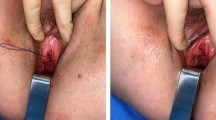Abstract
This study prospectively evaluated the position of the urethrovesical junction using the Q-tip angle to assess early postoperative changes for different anti-incontinence surgeries. All procedures resulted in a statistically significant change in resting angle from the intraoperative value. The mean change for the transvaginal tape was 25.74° (27.43 to 3.28); Burch 11.18° (−20.44 to −10.0) and fascia sling 13.9° (26.57 to 15.68). The mean change in Q-tip angle was greater after transvaginal tape placement than after Burch (p=0.000) and fascial sling (p=0.022) procedures. These findings show that the resting position of the urethrovesical junction after surgery is different for all procedures. The transvaginal tape results in the greatest change in angle. This may help to negate the so-called ‘tension-free’ nature of the procedure. Surgeons need to be aware of this, as it may be an etiological factor in cases of late urinary retention and urethral erosion.
Similar content being viewed by others
References
Ulmsten U, Henriksson L, Johnson P, Varhos G (1996) An ambulatory surgical procedure under local anesthesia for treatment of female urinary incontinence. Int Urogynecol J 7:81–86
Klutke C, Siegel S, Carlin B, Paszkiewicz E, Kirkemo A, Klutke J (2001) Urinary retention after tension-free vaginal tape procedure: incidence and treatment. Urology 58:697–701
Rackley RR, Abdelmalak JB, Tchetgen MB, Madjar S, Jones S, Noble M (2001) Tension-free vaginal tape and percuraneous vaginal tape sling procedures. Tech Urol 7:90–100
Lebret T, Lugagne P-M, Herve J-M et al. (2001) Evaluation of tension-free vaginal tape procedure. Eur Urol 40:543–547
Pit MJ (2002) Rare complications of tension-free vaginal tape procedure: Late intraurethral displacement and early misplacement of tape. J Urol 167:647
Romanzi LJ, Blaivas JG (2000) Protracted urinary retention necessitating urethrolysis following tension-free vaginal tape surgery. J Urol 164:2022–2023
Dietz HP, Mouritsen L, Ellis G, Wilson PD (2003) Does the tension-free vaginal tape stay where you put it? Am J Obstet Gynecol 188:950–953
Lo TS, Wang AC, Horng SG, Liang CC, Soong YK (2001) Ultrasonographic and urodynamic evaluation after tension free vagina tape procedure (TVT). Acta Obstet Gynecol Scand 80:65–70
Bakas P, Liapis A, Creatsas G (2002) Q-tip test and tension-free vaginal tape in the management of female patients with genuine stress incontinence. Gynecol Obstet Invest 53:170–173
Alterton MJ, Stanton SL (2000) A comparison of bladder neck movement and elevation after tension-free vaginal tape and colposuspension. Br J Obstet Gynaecol 2000;107:1366–1370
Madjar S, Tchetgen MB, Van Antwerp A, Abelmalak J, Rackley RR (2002) Urethral erosion of tension-free vaginal tape. Urology 59:601xi–601xii
Lieb J, Das AK (2003) Urethral erosion of tension-free vaginal tape. Scand J Urol Nephrol 37:184–185
Haferkamp A, Steiner G, Muller SC, Schumacher S (2002) Urethral erosion of tension-free vaginal tape. J Urol 167:250
Author information
Authors and Affiliations
Corresponding author
Additional information
Editorial Comment: The authors present a prospective observational study which compares the changes in position of the urethrovesical junction measured in the immediate postoperative period and at 6 weeks in patients undergoing transvaginal tape procedures, the Burch procedure and fascial slings for urinary incontinence.
There was no attempt at randomization of subjects, and the study groups were poorly matched. Only 15% of the patients undergoing transvaginal tape procedures reported previous surgery for urinary incontinence, compared to 29% of those undergoing Burch procedures. The number of Burch procedures studied was comparatively small.
However, this study does provide evidence that there are significant postoperative changes in the position of the urethrovesical junction, which appear more marked for the transvaginal tape procedures than for the Burch or fascial sling procedures. This study also questions the ‘tension-free’ nature of the transvaginal tape procedures.
The findings from this study should be confirmed in a larger prospective randomized trial with longer patient follow-up.
Rights and permissions
About this article
Cite this article
McLennan, M.T., Melick, C.F. & Cannon, S. The position of the urethrovesical junction after incontinence surgery: early postoperative changes. Int Urogynecol J 15, 44–48 (2004). https://doi.org/10.1007/s00192-003-1117-5
Received:
Accepted:
Published:
Issue Date:
DOI: https://doi.org/10.1007/s00192-003-1117-5




